Key Tips for Growing a Healthy Anthurium White Plant
To grow a healthy Anthurium White, guarantee it receives bright, indirect light and avoid direct sunlight. Water when the top inch of soil is dry using a well-draining mix with orchid bark, perlite, and peat moss.
Maintain temperatures between 65°F and 80°F with humidity levels between 70% and 80%. Prune dead leaves regularly and monitor for pests, using organic methods for control.
Repot with care, guaranteeing good drainage, during the growing season. Address common issues like yellowing leaves by adjusting watering routines.
Learn more to master advanced techniques and troubleshooting for your plant’s prime health.

Key Takeaways
- Provide bright, indirect light and position near a north or east-facing window.
- Maintain consistent soil moisture, watering when the top inch is dry.
- Ensure temperatures between 65°F and 80°F with humidity levels at 70% to 80%.
- Use a well-draining potting mix with orchid bark, perlite, and peat moss.
- Prune dead or yellowing leaves to promote plant health and aesthetics.
Optimal Lighting Conditions

To safeguard your Anthurium White plant thrives, you must provide it with bright, indirect light, which mimics its natural understory habitat. Direct exposure to intense sunlight can cause leaf scorching, while insufficient light reduces blooming potential.
Place your plant near north or east-facing windows where it can benefit from diffused sunlight. Alternatively, use sheer curtains to filter harsh rays. During winter, consider supplemental lighting with fluorescent or LED grow lights, maintaining a light intensity of 10,000 to 20,000 lux.
Rotate your plant periodically to secure even light distribution and prevent uneven growth. Monitoring the leaves can offer additional insights; pale leaves indicate too much light, while dark green leaves suggest insufficient light. Your plant’s health hinges on achieving this delicate balance.
Watering Schedule
Maintaining consistent moisture levels is vital for your Anthurium White plant’s health. So make sure the soil remains evenly moist but not waterlogged.
Research indicates that overwatering can lead to root rot, which compromises the plant’s ability to absorb nutrients.
Utilize a well-draining potting mix and monitor the soil moisture frequently to mitigate these risks.
Consistent Moisture Levels
Ensuring your Anthurium White plant receives consistent moisture is essential, as erratic watering schedules can lead to root rot or dehydration.
Research shows that maintaining even soil moisture supports ideal growth. You should water when the top inch of soil feels dry, ensuring the soil remains moist but not waterlogged.
| Observation | Action |
|---|---|
| Top inch of soil is dry | Water thoroughly until drainage occurs |
| Soil feels consistently damp | Reduce watering frequency slightly |
| Leaves appear wilted | Increase watering frequency |
| Soil is soggy | Allow soil to dry out partially |
Avoid Overwatering Risks
Overwatering poses significant risks to your Anthurium White plant, making it crucial to establish a precise watering schedule.
Research indicates that Anthuriums thrive in well-draining soil with consistent moisture rather than saturation. To avoid root rot, water your plant only when the top inch of soil feels dry to the touch.
It’s vital to use a pot with drainage holes to prevent water from pooling at the bottom. Additionally, employ a moisture meter to gain accurate readings and adjust your watering frequency accordingly.
During colder months, reduce watering since the plant’s growth rate decreases. By maintaining this careful balance, you guarantee your Anthurium White remains healthy and vibrant, free from the detrimental effects of overwatering.
Ideal Temperature Range
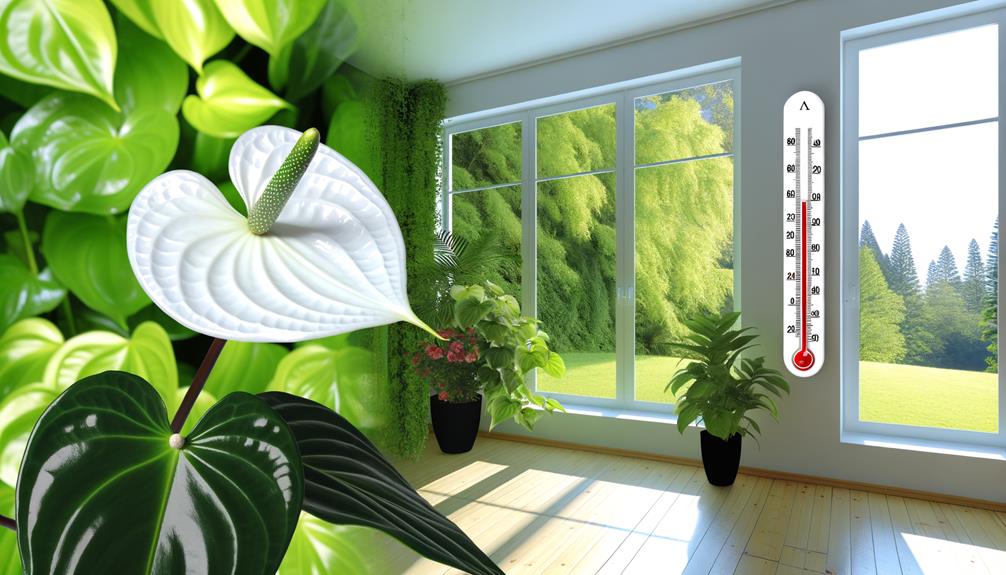
To maximize the growth of your Anthurium White, maintain an ideal temperature range between 65°F and 80°F. Avoid extreme fluctuations, as drastic changes can stress the plant and impede growth.
Additionally, balance humidity and temperature by keeping the environment consistently warm and humid, ideally around 70% humidity.
Optimal Temperature Maintenance
Maintaining a perfect temperature range of 70-85°F during the day and around 60-70°F at night is crucial for the healthy growth of your Anthurium White plant.
This temperature range mimics the plant’s native tropical environment, promoting optimal metabolic functions and nutrient uptake.
You should monitor your home’s ambient temperature with a reliable thermometer, adjusting your HVAC settings as necessary.
When temperatures exceed the ideal range, the plant may experience thermal stress, negatively impacting photosynthesis and growth rates.
Conversely, nighttime temperatures below 60°F can inhibit root function and slow down physiological processes.
By consistently maintaining these temperature parameters, you’ll guarantee your Anthurium White thrives, exhibiting vibrant foliage and prolonged blooming periods.
Avoid Extreme Fluctuations
Another critical aspect of temperature management is ensuring your Anthurium White plant isn’t subjected to extreme fluctuations, which can stress the plant and disrupt its metabolic processes.
Aim to maintain a stable temperature range between 65°F and 80°F. Sudden drops below 55°F or spikes above 90°F can impair photosynthesis and nutrient uptake. Use a digital thermometer to monitor the environment closely.
Night temperatures should ideally remain within 10°F of daytime levels to avoid thermal shock. Gradual adjustments are key—abrupt changes can lead to leaf yellowing or browning, compromising plant health.
Humidity and Temperature Balance
Balancing humidity and temperature is crucial for an Anthurium White plant’s health, maximizing its growth in its environment.
Aim to maintain a temperature range between 70°F and 85°F during the day and not below 60°F at night. Consistent temperatures within this range prevent stress and promote peak growth.
Humidity should be kept between 60% and 80%. If your environment is dry, consider using a humidifier or placing the plant on a humidity tray.
Avoid placing your Anthurium near drafts or heating vents, as sudden temperature changes can impede its development.
Monitoring these conditions closely guarantees your Anthurium White maintains its stunning foliage and blooms beautifully, creating an intimate and vibrant atmosphere in your space.
Humidity Requirements
Anthurium White plants flourish in environments where the relative moisture level is consistently maintained between 70% and 80%. Sustaining this level of moisture is essential for preventing leaf dehydration and supporting peak foliar health.
You can achieve this by using a humidifier or placing your plant atop a water-filled pebble tray. Regular misting also helps, but be careful to avoid waterlogging. Monitoring moisture levels with a hygrometer ensures accuracy.
Low moisture leads to browning leaf edges, while excessively high levels can cause fungal issues. Balancing your home’s moisture levels not only enhances your Anthurium’s robustness but also replicates its native tropical habitat.
Soil Mix
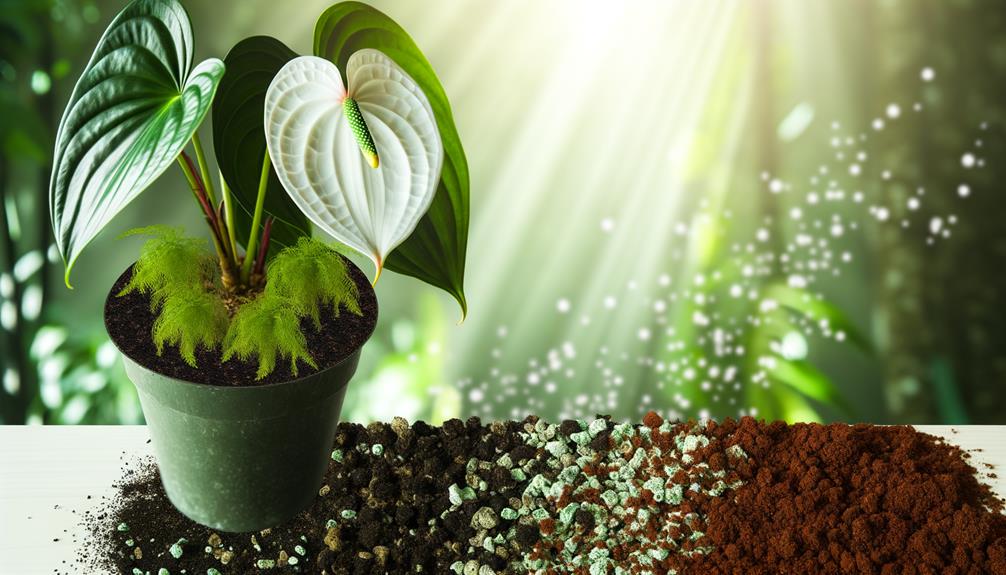
Choosing the correct soil mix is essential for ensuring ideal root aeration and drainage for your Anthurium White plant. You’ll want a well-draining, chunky mix to prevent waterlogging and root rot.
A recommended blend includes equal parts orchid bark, perlite, and peat moss. Orchid bark provides the necessary chunky texture, enhancing air circulation around the roots. Perlite improves drainage, preventing excess moisture buildup. Peat moss retains optimal moisture without becoming waterlogged.
You might also consider adding charcoal to filter toxins and keep the soil fresh. Avoid heavy, compact soils; these can suffocate the roots and hinder growth. By carefully selecting and preparing your soil mix, you maximize your Anthurium’s growth in an environment mimicking its natural tropical habitat.
Fertilization Tips
To ensure robust growth and vibrant blooms, fertilize your Anthurium White plant every 6-8 weeks with a balanced, water-soluble fertilizer diluted to half strength.
This guarantees essential nutrients reach the roots without overwhelming them. Implementing a regular fertilization schedule maximizes nutrient uptake, which is vital for photosynthesis and resistance to diseases.
Follow these steps:
- Select a 20-20-20 fertilizer: This balanced ratio supports even distribution of nitrogen, phosphorus, and potassium.
- Dilute to half potency: Full-strength solutions can cause root burn and damage.
- Apply during the growing season: Fertilize from spring through early autumn when the plant is actively growing.
- Monitor pH levels: Maintain the soil pH between 5.5 and 6.5 to optimize nutrient absorption.
Consistency is essential for a thriving Anthurium White.
Pruning Techniques
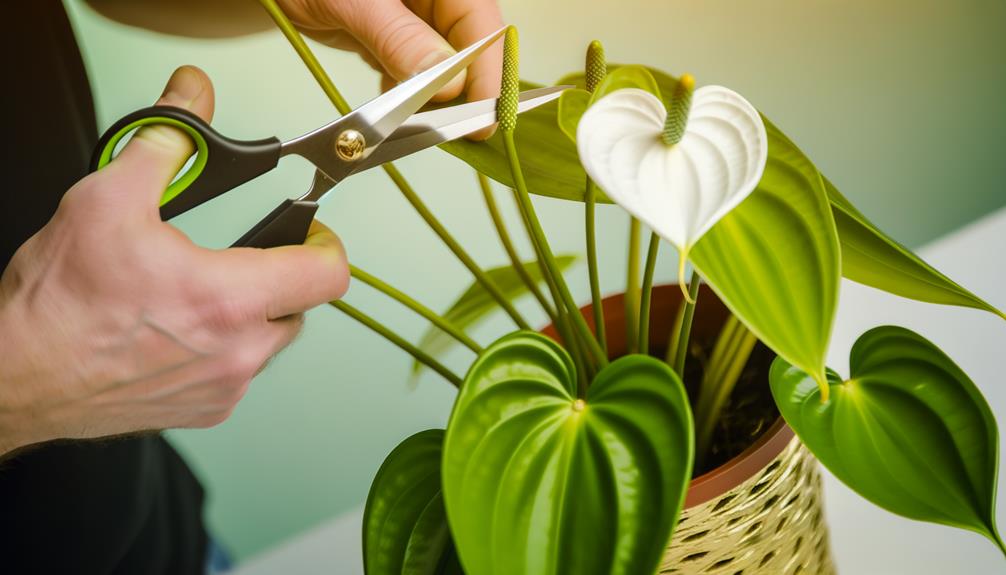
When pruning your Anthurium White plant, focus on removing dead or yellowing leaves to maintain its health and encourage new growth. Use sterilized pruning shears to make clean cuts close to the base of the stem. This prevents the spread of pathogens.
Regularly inspect your plant for any damaged or discolored leaves, as these can harbor diseases and pests. It’s essential to prune during the growing season, typically spring and summer, to optimize recovery and new leaf production.
Additionally, remove any spent flowers to redirect the plant’s energy towards foliage growth. By maintaining this routine, you’ll guarantee your Anthurium White remains vigorous and lush, enhancing both its aesthetic appeal and overall wellness.
Pest Management
To maintain your Anthurium White plant’s health, it’s important to identify common pests like aphids, spider mites, and mealybugs early. Employ organic control methods such as neem oil and insecticidal soap to manage infestations effectively.
Additionally, follow preventative measures like regular inspections and maintaining ideal humidity levels to reduce pest occurrences.
Common Pests Identification
Identifying common pests is essential for effective pest management in maintaining a healthy Anthurium White plant. You need to be vigilant and inspect your plant regularly.
Some pests that target the Anthurium White include:
- Spider Mites: These tiny arachnids suck plant sap, causing stippled leaves and webbing.
- Mealybugs: These pests form cotton-like masses, feeding on plant sap and excreting honeydew, leading to sooty mold.
- Aphids: Small, soft-bodied insects that cluster on new growth, distorting leaves and stems.
- Scale Insects: These pests appear as small, oval bumps on stems and leaves, sucking sap and weakening the plant.
Organic Control Methods
Implementing organic control methods guarantees that your Anthurium White plant remains healthy without relying on harmful chemicals. Begin by introducing beneficial insects like ladybugs and lacewings, which prey on common pests such as aphids and spider mites.
Neem oil, a natural pesticide, disrupts the life cycle of many harmful insects without affecting beneficial ones. Use a diluted solution of neem oil, applying it to the leaves and stems every two weeks.
Companion planting with herbs like basil or marigold can also deter pests. Additionally, a homemade insecticidal soap—crafted from mild liquid soap and water—can be sprayed directly onto pests.
These solutions provide effective, eco-friendly pest control, ensuring your Anthurium White thrives in a balanced, chemical-free environment.
Preventative Measures Tips
Maintaining a regular inspection schedule is key to preventing pest infestations in your Anthurium White plant. By examining the plant weekly, you can spot early signs of trouble and take swift action.
Here are four essential tips for effective pest management:
- Inspect Leaves and Stems: Look for discoloration, holes, or sticky residues, which indicate the presence of pests like aphids or spider mites.
- Maintain Cleanliness: Remove fallen leaves and debris from the soil surface to reduce hiding places for pests.
- Ensure Proper Air Circulation: Good airflow helps prevent fungal growth and deters pest infestations.
- Use Neem Oil: This organic treatment can effectively deter common pests. Apply it as a preventative measure every few weeks.
Following these steps will safeguard your Anthurium White from potential pest issues.
Repotting Guidelines
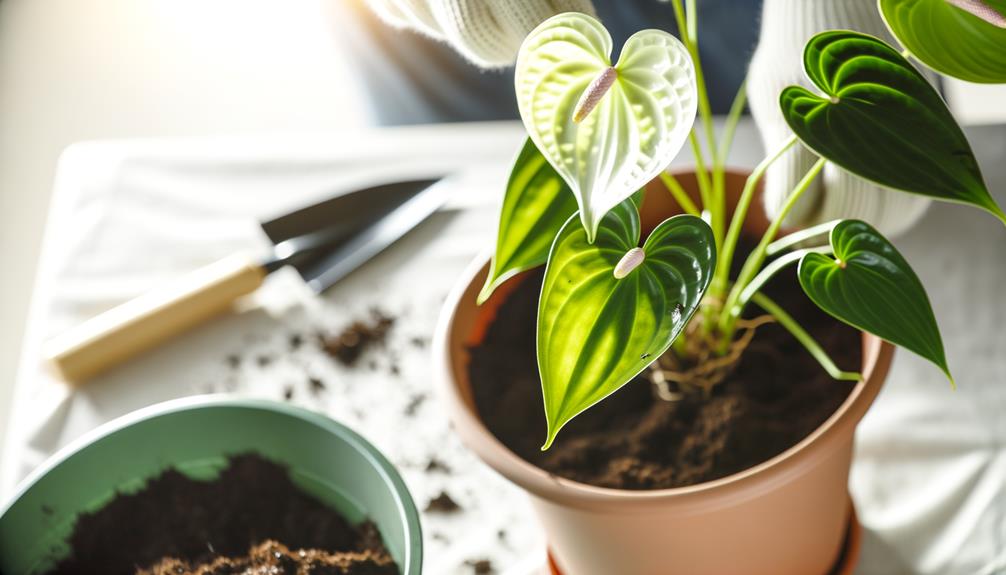
When repotting your Anthurium White, make sure you select a pot that’s only slightly larger than the current one to prevent waterlogging and root rot. Choose a well-draining potting mix, preferably one that includes orchid bark, charcoal, and perlite to ensure optimal aeration.
Gently remove the plant from its existing pot, shaking off excess soil from the roots. Inspect the roots for any signs of decay and trim if necessary. Place the plant in the new pot, adding the fresh mix around it while ensuring it’s at the same depth as before.
Water thoroughly to settle the soil, but avoid excessive watering. Repotting is best done during the growing season, typically in spring or early summer.
Propagation Methods
To propagate your Anthurium White effectively, consider using the division method, which involves separating the plant into smaller sections, each with a healthy root system and foliage. This method guarantees the best chances of successful growth.
Follow these steps:
- Prepare Tools and Environment: Use sterilized pruning shears and a clean workspace to prevent infection.
- Select a Healthy Plant: Choose a mature Anthurium White with multiple stems, ensuring it’s robust.
- Divide the Plant: Gently separate the root ball into sections, guaranteeing each has sufficient roots and leaves.
- Replant and Water: Place each division in a well-draining potting mix, water lightly to settle the soil, and put it in indirect light.
These steps will help your plant thrive.
Common Issues and Solutions
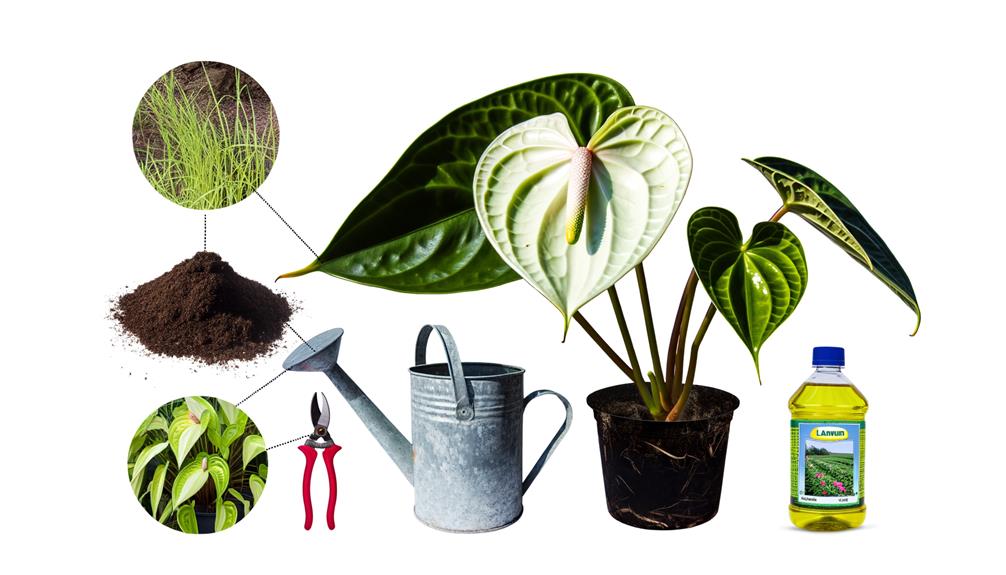
Encountering yellowing leaves, root rot, or pest infestations in your Anthurium White can be frustrating, but understanding the root causes and implementing targeted solutions will guarantee your plant’s health and longevity.
Yellowing leaves often indicate overwatering or nutrient deficiencies. Ensure well-draining soil and balanced fertilization. Root rot is commonly caused by poor drainage; repot with fresh soil and prune affected roots.
Pest infestations, like aphids or spider mites, can be managed using insecticidal soap or neem oil. Monitoring your plant regularly and adapting care practices can preemptively address issues.
| Issue | Solution |
|---|---|
| Yellowing Leaves | Check watering; ensure balanced fertilization |
| Root Rot | Improve drainage; prune affected roots |
| Pest Infestations | Use insecticidal soap or neem oil |
| Leaf Browning | Increase humidity; avoid direct sunlight |
| Wilting | Adjust watering routine; check soil moisture |
Anthurium White Plant Size
The size of a white Anthurium plant can vary depending on its specific variety and growing conditions. Generally, Anthurium plants can range in height from about 12 inches (30 cm) to 3 feet (90 cm) tall.
The leaves can grow between 6 inches (15 cm) to 18 inches (45 cm) in length. The flowers, including the spathe and spadix, typically range from 3 inches (7.5 cm) to 8 inches (20 cm) in size.
For more precise measurements, it’s best to refer to the specific variety of white Anthurium you have.
Anthurium Baby White
“Anthurium Baby White” is a cultivar of Anthurium known for its compact size and delicate white flowers. Here are some details:
- Height: Typically, the “Anthurium Baby White” grows to about 10-12 inches (25-30 cm) in height.
- Leaves: The leaves are smaller compared to standard Anthurium varieties, generally around 4-6 inches (10-15 cm) in length.
- Flowers: The white spathes (the modified leaf that looks like a flower) are usually about 2-4 inches (5-10 cm) in size, with a contrasting spadix in the center.
- Growth: This variety is known for its compact growth habit, making it ideal for smaller spaces and indoor environments.
It’s a popular choice for indoor gardening due to its manageable size and elegant appearance.
Conclusion
To sum up, cultivating a healthy Anthurium white plant might seem challenging, but it’s entirely manageable with the right care. By ensuring best lighting, a proper watering schedule, and maintaining ideal temperature and humidity levels, you’ll watch your plant thrive.
Don’t fret about the occasional pest; regular checks and prompt action will keep them at bay. Picture your Anthurium’s vibrant white blooms standing tall and elegant, a sign of your meticulous care and dedication.






